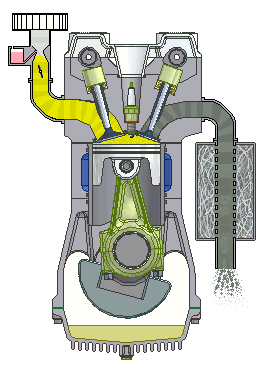 Image via Wikipedia
Image via WikipediaFriction causes wear; it's a law of physics. Small gas engines can wear out prematurely if moving parts aren't lubricated. We'll discuss how to reduce wear on your small engine and increase its useful life by servicing the lubrication system. Topics include the fuel-oil mixture for two-stroke engines and performing other lubrication services.
Always use the type and viscosity grade of oil recommended by the engine manufacturer. Lubricating oils and additives designed for four-stroke engines are not suitable for two-stroke engines.
Mixing Fuel-Oil for Two-Stroke Engines
Two-stroke engines are efficient. They only require a single rotation of the crankshaft to develop power. This simplicity requires economy in all engine systems, including lubrication. A two-stroke engine is lubricated by mixing oil with the gasoline. This fuel-oil mixture can be purchased as such, or you can mix it yourself. Here's how to make a two-stroke engine fuel-oil mixture:
Step 1: Check the manufacturer's recommendations for the specific ratio and grade of oil and fuel to be mixed.
Step 2: In a vented gas can used only for mixing, pour a specified amount and type of gasoline.
Step 3: Add the correct amount of recommended oil for the fuel-oil ratio. A gallon contains 128 ounces. A fuel-oil ratio of 50:1 means 50 ounces of fuel should have 1 ounce of oil added, or you should add about 2.5 ounces of recommended lubricating oil to every gallon of recommended gasoline. A 25:1 fuel-oil ratio requires about 5 ounces of oil per gallon of fuel. Also pour in any additives recommended by the manufacturer.
Step 4: Make sure all caps are securely fastened to the mixing gas can, and shake it to thoroughly mix the fuel and oil.
Step 5: Carefully pour the resulting fuel-oil mixture into the engine's fuel tank.
Step 6: Whether you purchase fuel-oil mixed or mix it yourself, rotate the fuel tank in a circle a few times to remix the fuel and oil before each use.
Lubrication Service
Some small engines require additional lubrication, depending on their design and the tasks they perform. A riding lawn mower, for example, may require lubrication of the axles and steering box. Though this article can't cover all possible lubrication service procedures, it can offer procedures that are easily adaptable to most small engines.
Lubrication service is the application of lubricating greases. Greases are simply petroleum products with higher viscosity or thickness than oils. A lubricating grease may have a grade as low as 60 (about twice as thick as 30 grade oil) to over 100. Common viscosities for lubricating greases are 80 and 90 grade. At these viscosities, lubricants have the density of toothpaste. Special tools called lube guns are used to apply lubricating greases. Professional repair shops use pressurized lube guns; the engine owner can apply lubricating greases with a ratchet lube gun. The greases are sold in tubes that fit into the lube gun. Here's how to apply lubricating grease to small engine components:
Step 1: Check the owner's manual for specific information on lubrication: where and with what.
Step 2: Apply the recommended grade of lubricating grease. Some components have fittings to which the end of the lube gun is attached. Others require that the top of a reservoir is opened and fluid added to a specific FULL point. Still other components require that a lubricant such as white grease be spread on the part by hand.
Caution: Make sure that lubricating greases do not touch electrical parts. Lubricants can conduct electricity, shorting out the system and potentially causing a fire.
A defective cooling system can ruin a small engine. Learn how to properly maintain and service a cooling system in the next section.





